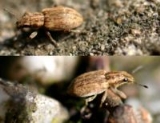
Sitona
Encyclopedia
Sitona is a large genus
of weevil
s in the family Curculionidae
, native to the Nearctic
and Palaearctic regions. More than 100 species have been described. Sitona is easily distinguished from related genera by flat, recumbent scales on the mandibles
, by the absence of an oval scar on the mandibles, by short and broad rostrum
with a deep, longitudinal, median groove, and by dense scales on the body. They are phytophagous, with larvae feeding exclusively on plants of the family Fabaceae
. Several species of Sitona are important agricultural pests of legumes, especially in its native regions and introduced populations in South Africa, Australia and New Zealand. It is likely that the larvae of Sitona feed on the nitrifying root nodule
s.
Genus
In biology, a genus is a low-level taxonomic rank used in the biological classification of living and fossil organisms, which is an example of definition by genus and differentia...
of weevil
Weevil
A weevil is any beetle from the Curculionoidea superfamily. They are usually small, less than , and herbivorous. There are over 60,000 species in several families, mostly in the family Curculionidae...
s in the family Curculionidae
Curculionidae
Curculionidae is the family of the "true" weevils . It was formerly recognized in 1998 as the largest of any animal family, with over 40,000 species described worldwide at that time...
, native to the Nearctic
Nearctic
The Nearctic is one of the eight terrestrial ecozones dividing the Earth's land surface.The Nearctic ecozone covers most of North America, including Greenland and the highlands of Mexico...
and Palaearctic regions. More than 100 species have been described. Sitona is easily distinguished from related genera by flat, recumbent scales on the mandibles
Mandible (arthropod)
thumb|250px|The mandibles of a [[Bull ant]]The mandible of an arthropod is either of a pair of mouthparts used for biting, cutting and holding food. Mandibles are often simply referred to as jaws. Mandibles are present in the extant subphyla Myriapoda , Crustacea and Hexapoda...
, by the absence of an oval scar on the mandibles, by short and broad rostrum
Rostrum (anatomy)
The term rostrum is used for a number of unrelated structures in different groups of animals:*In crustaceans, the rostrum is the forward extension of the carapace in front of the eyes....
with a deep, longitudinal, median groove, and by dense scales on the body. They are phytophagous, with larvae feeding exclusively on plants of the family Fabaceae
Fabaceae
The Fabaceae or Leguminosae, commonly known as the legume, pea, or bean family, is a large and economically important family of flowering plants. The group is the third largest land plant family, behind only the Orchidaceae and Asteraceae, with 730 genera and over 19,400 species...
. Several species of Sitona are important agricultural pests of legumes, especially in its native regions and introduced populations in South Africa, Australia and New Zealand. It is likely that the larvae of Sitona feed on the nitrifying root nodule
Root nodule
Root nodules occur on the roots of plants that associate with symbiotic nitrogen-fixing bacteria. Under nitrogen-limiting conditions, capable plants form a symbiotic relationship with a host-specific strain of bacteria known as rhizobia...
s.
Partial species list
- Sitona crinitus
- Sitona discoideus Gyllenhal
- Sitona fairmairei Allard, 1869
- Sitona lepidusSitona lepidusSitona lepidus or Clover Root Weevil is a species of weevil found in Europe. It has now spread to North America and New Zealand.S. lepidus was found in New Zealand pastures in 1996 and poses a threat to farm productivity since it damages the clover plant...
Gyllenhal - Sitona lineatus
- Sitona sulcifrons

